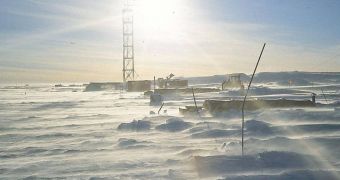In a new scientific investigation, researchers determined that the Southern Hemisphere saw significantly different biomass burning patterns than the Northern Hemisphere, a finding that may prompt changes in several renowned climate models.
The new discovery was made as experts were analyzing an ice column harvested from Antarctica, which covered the span of about 650 years. The team was primarily keeping track of carbon monoxide (CO) variations in the data.
For the purpose of the research, biomass burning was defined as the utilization of wood, peat and other similar materials for cooking fires and communal fires, as well as their consumption during wildfires.
The main conclusion of the study was that the Southern Hemisphere was subjected to fluctuations in biomass burning patterns, that are not in tune with the fluctuations discovered at the North Pole.
According to the team behind the work, this is the first time ice core-based CO measurements are used in this manner. The group focused on analyzing variations of stable isotopes of carbon and oxygen.
A stable isotope is a form of a certain chemical that is not radioactive, and does not decay. The work is detailed int eh December 2 early online issue of the top journal Science.
“Combined with concentration measurements of CO, this record allows us to constrain the relative strength of biomass burning activity over the 650-year period in the Southern Hemisphere,” explains expert John Mak.
“What we find is that the amount of biomass burning has changed significantly over that time period, and that biomass burning was in fact a significant source of CO during pre-industrial times,” he adds.
Mak, the lead researcher on the new investigation, holds an appointment as a geoscientist at the SUNY Stony Brook, and is also the coauthor of the new research paper.
He explains that his team validated its results by cross-referencing them with datasets on methane trapped in ice, and of charcoal particles found buried inside sediments in the Southern Hemisphere.
An interesting conclusion of the new work was that a lot more biomass was burned between 150 and 100 years ago than during the entire 20th century, experts at the US National Science Foundation (NSF) report.
“While this is consistent with previous findings, there is still a common mis-perception that biomass burning rates are much higher today than in the past,” Mak explains.
“This is significant since many researchers assume that human-induced biomass burning is much greater than 'naturally' occurring biomass burning,” he goes on to say.
“While this may still be the case – there were people around in the 18th century – the fact that today's rates of [Southern Hemisphere] biomass burning seem to be lower than one to two centuries ago calls for a re-evaluation of sources,” he concludes.
The NSF supported this research through a grant provided through its Division of Ocean Sciences (DOS).

 14 DAY TRIAL //
14 DAY TRIAL //